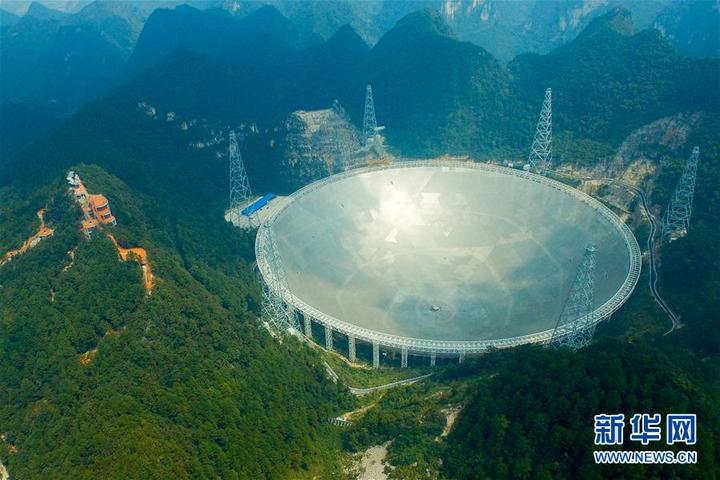Eyes wide open: China's Tianyan telescope a sight to behold
By Cui Can
It is one of the hottest new attractions in China, unless you count it by the tourists holding up cameras at the site -- there are none. Cameras, cellular phones and other electronics are banned at the visitors platform of the Five-hundred-meter Aperture Spherical radio Telescope (FAST), nicknamed Tianyan, or the Eye of Heaven.
An aerial view of the Five-hundred-meter Aperture Spherical radio Telescope (FAST) in Pingtang County, Southwest China's Guizhou Province on Sept. 24, 2016, a day before the telescope's launch. [Photo/Xinhua]
Because the telescope is designed to pick up radio and gravitational waves from deep space, it is incredibly sensitive to electromagnetic interference. Therefore, local authorities have strictly forbidden facilities and equipment that generate electromagnetic radiation waves within a five-kilometer radius of the telescope's core area. Meanwhile, the number of tourists is restricted to under 2,000 per day in order to better protect the FAST's research work, according to Pingtang tourism officials.The FAST is the world's largest telescope dish, taking up the entire Dawodang depression, a natural basin in Pingtang County of southwest China's Guizhou Province. The telescope is currently in a calibrating phase and set to become fully operational by the end of 2019.
Despite these measures, tourists have been arriving in droves since September 2016, when the telescope officially completed construction. Over 240,000 have visited the core area of FAST in the first year, according to the Pingtang tourism officials in a report by Guizhou Daily.
After leaving behind all their electronics at the Pingtang Astronomy Town, more than 5 kilometers away, the visitors are taken by bus on a steep, winding road and make way through a string of small villages.They also climb up 800 steps on a zigzag stairway along the mountainside to reach the observation platform overlooking the telescope.
Then comes the breathtaking view of the giant silver dish of the world's largest telescope, spanning the area of 30 soccer fields. It consists of 4,450 triangular panels, reflecting shimmering sunlight to the naked eye, but more importantly gathering invisible signals from faraway galaxies.
Finding the beacons in the universe
"It's hard to imagine how a massive project like this could be carried out in just few decades," said Cao Yu, a media reporter from Beijing.
This massive engineering feat was first conceptualized in the early 1990s by the late Chinese astronomer Nan Rendong, who became the chief scientist and chief engineer of the FAST. He put forward the idea of building a new dish in China's karst mountain region to search for extraterrestrial intelligence.
Through using satellite imagery to pick out candidate sites and on-the-spot investigation, a perfect bowl to hold the giant dish was finally found in Guizhou Province. The site is guarded by green mountains -- natural barriers to protect FAST's sensitive ear from wind and radio noise. The project began construction in 2011, and was completed on Sept. 25, 2016, a few days after Nan's passing due to lung cancer.
After more than 20 years' persistent efforts, the FAST project of 1.2 billion yuan (US$180 million) has now been put into trial operation and is already making strides in space discovery.
On Oct. 10, scientists at the National Astronomical Observatories of China announced the discovery of six pulsars -- super dense cores of massive stars that went supernova and died -- using the FAST.
Dubbed as "beacons in the universe," these pulsars will help Chinese researchers tackle major scientific issues, such as the origin and evolution of the universe, as well as navigating spacecraft in the future space travel.
Boosting local tourism
Since the building of the FAST in 2016, local tourism has developed rapidly by zeroing in on the theme of astronomical science. Pingtang Astronomy Town, the base camp for enthusiasts planning visits to the telescope,is fast becoming an international astronomy tourism destination.
Yu Xinghong, a 27-year-old tour guide for the scenic spots near the FAST,gave instructions to the tourists with pride and excitement.
"Lying in the middle of the big dish is the feedback source cabin, which could receive signals from outer space. Then scientists will further analyze these data in detail," Yu said, adding that major breakthroughs made in only one year after the launch of the project are closely related to these scientists' hard work.
Yu said she used to be one of the residents in Pingtang County near the telescope. She was relocated along with other residents to another town when the giant telescope used to search for signals from other worlds was being planned. Now, she said that they are enjoying better living standards. "Sometimes my friends who admire my luck would make a joke, saying 'you should thank the aliens,'" Yu said in a smile.
"I am very proud of being the guide tour to introduce this great project to tourists," Yu said. "Though I never thought about I would move to make way for a telescope before, now I think this is something that really could change our life and maybe the future."
According to Pingtang tourism officials, a total of over 5.5 billion yuan in tourism revenue was generated since the FAST finished construction, with an annual growth of 26.82 percent. The building of this telescope directly created 20,000 jobs, and the total number of jobs created from developing the astronomy tourism industry, directly and indirectly, was 33,000. Roughly 70 percent of the local residents are benefiting from it, they said.
At present, the local government is considering an investment of 4.9 billion yuan to build towns around the telescope in a bid to further develop astronomy tourism without interfering with the science research, according to the officials.
